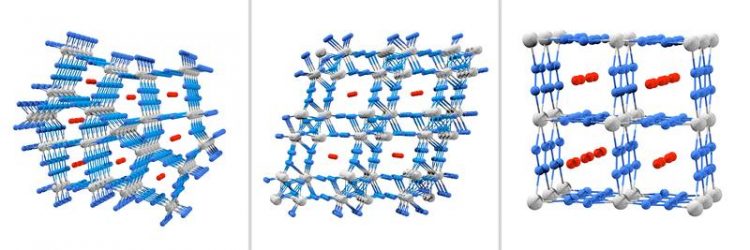Bayreuth high-pressure researchers discover nitrogen compounds with surprising structures

Metallic inorganic framework structures with osmium, hafnium and tungsten (Os₅N₂₈, Hf₄N₂₀ and WN₈, from left to right). Nitrogen atoms: blue, metal atoms: yellow, nitrogen molecules: red. Illustrations: Maxim Bykov
Counter-intuitive: high pressure creates cavities
It's an everyday experience: the stronger the pressure you put on an object from all sides, the more it is compressed. The volume decreases, hollow spaces inside disappear.
Yet it is precisely this experience that the new high-pressure experiments at the University of Bayreuth contradict. At a compression pressure of around one million atmospheres, such as exists around 2,500 kilometres below the Earth’s surface, porous framework structures are formed from nitrogen atoms and the atoms of a metal.
Here, nitrogen atoms build up zigzag chains, for example. Nitrogen molecules (N₂) penetrate into the cavities of the new crystals. The metals used in the experiments were hafnium (Hf), tungsten (W), and osmium (Os). These belong to the group of transition metals due to their positions in the periodic table of elements.
High pressure prompts nitrogen to bond
Under the normal pressures and temperatures we are familiar with on Earth, nitrogen molecules are very unwilling to react with elements and compounds.
“It is therefore fascinating to observe how radically the binding behaviour of nitrogen changes under high pressure. Complex framework structures are formed which contain different types of chemical bonds. In any case, these structures are porous – which is very unusual when you consider, for example, how layered graphite transforms into compact and very hard diamond under high pressure”, explains Prof. Dr. Natalia Dubrovinskaia from the Laboratory for Crystallography at the University of Bayreuth, who was significantly involved in the new study.
The appearance of the complex framework structure which is created in each individual case depends crucially on the choice of transition metal. In principle, this means that the synthesis of the nitrides can be controlled in a targeted manner – at least under the high pressures that can be produced in the laboratory.
“In view of the growing technological importance of nitrides, for example for electronics and energy storage, our new study offers numerous prospects for the development of new high-tech materials,” says Dr. Maxim Bykov, first author of the study, who completed his doctorate at the Laboratory for Crystallography at the University of Bayreuth, and worked until 2019 as a postdoc at the Bavarian Research Institute of Experimental Geochemistry & Geophysics (BGI) of the University of Bayreuth.
International cooperation
The new scientific discoveries are the result of close international research cooperation: Together with high-pressure researchers from Bayreuth, working groups from the University of Chicago, the Carnegie Institution of Washington, and Howard University in the USA, the National University of Science and Technology MISiS in Moscow/Russia, Linköping University in Sweden, the European Synchrotron Radiation Facility in Grenoble/France (ESFR), and the German Electron Synchrotron (DESY) in Hamburg were all involved.
Research funding
The research work at the University of Bayreuth was funded by the German Research Foundation (DFG) and the Federal Ministry of Education and Research (BMBF).
Prof. Dr. Natalia Dubrovinskaia
Laboratory for Crystallography
University of Bayreuth
Phone: +49 (0)921 55-3880
E-Mail: natalia.dubrovinskaia@uni-bayreuth.de
Maxim Bykov et al.: High‐pressure synthesis of metal‐inorganic frameworks Hf4N20·N2, WN8·N2, and Os5N28·3N2 with polymeric nitrogen linkers. Advanced Materials International Edition (2020), doi: https://doi.org/10.1002/ange.20200248
Media Contact
More Information:
http://www.uni-bayreuth.de/All latest news from the category: Materials Sciences
Materials management deals with the research, development, manufacturing and processing of raw and industrial materials. Key aspects here are biological and medical issues, which play an increasingly important role in this field.
innovations-report offers in-depth articles related to the development and application of materials and the structure and properties of new materials.
Newest articles

How marine worms regenerate lost body parts
The return of cells to a stem cell-like state as the key to regeneration. Many living organisms are able to regenerate damaged or lost tissue, but why some are particularly…

Nano-scale molecular detective
New on-chip device uses exotic light rays in 2D material to detect molecules. Researchers have developed a highly sensitive detector for identifying molecules via their infrared vibrational “fingerprint”. Published in Nature…

Novel CAR T-cell therapy
… demonstrates efficacy and safety in preclinical models of HER2-positive solid tumors. The p95HER2 protein is found expressed in one third of HER2+ tumors, which represent 4% of all tumors….



